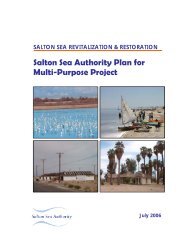Salton Sea Preliminary In-Sea Geotechnical Investigation
Salton Sea Preliminary In-Sea Geotechnical Investigation
Salton Sea Preliminary In-Sea Geotechnical Investigation
Create successful ePaper yourself
Turn your PDF publications into a flip-book with our unique Google optimized e-Paper software.
SECTIONFIVE<strong>Preliminary</strong> Engineering Characterizationeffective stress were developed at individual sample locations and for all the samples within the unit,excluding anomalous points. Figures in Appendix C of this report provide the test results.5.2.3 CompressibilityThis unit is interpreted to be slightly overconsolidated with an OCR of 1.5 recommended for conceptualdesign. A graphical interpretation of the preconsolidation pressure (σ p ) using the strain versus the log ofvertical effective stress (σ v ’) test data was the primary method of interpretation. However, engineeringjudgment considering the varied geologic environment of the surface of the <strong>Sea</strong> bottom along withundrained shear strength versus depth profiles were also considered to develop this assessment.Assessment of OCR based on the water content relative to the Liquid and Plastic Limit, could suggest adifferent interpretation for this unit and the other fine-grained soil units. However, for conceptual designpurposes, we recommend adopting normally consolidated to slightly overconsolidated conditions.A C C of 0.65 and C r of 0.10 are recommended for conceptual design. The C c data from six tests rangedfrom 0.23 to 1.10. One sample swelled and therefore it was discounted from further interpretation. Theseparameters were developed from graphical interpretations of the strain versus log of effective stress (σ v ’)plots and inspection of this data relative to a plot of CR correlated to water content (refer to Figure 23).The Compression <strong>In</strong>dex was also related to the commonly used expression C C = 0.009 (LL-10). Therecommended C r was taken as 15 percent of the C C . Table 6 summarizes the consolidation test data.A complete discussion of potential consolidation settlement is presented elsewhere in this report.However, an average LI of 0.81 suggests a potential for significant consolidation settlement.A coefficient of consolidation (c v ) of 15 feet squared per year (ft 2 /yr) is recommended for conceptualdesign. However, considering the variability of this parameter, conceptual design analyses shouldconsider using a range from 10 to 40 ft 2 /yr. This parameter was developed using the relevant portions ofthe oedometer test data and correlation to the LL. The lab data ranged from 8 to 43 ft 2 /yr. Correlations toLiquid Limit ranged from 12 to 40 ft 2 /yr.5.3 SOFT LACUSTRINE DEPOSITS5.3.1 <strong>In</strong>dex PropertiesSamples tested from this unit consist of fine-grained materials classified predominantly as fat clay (CH).The plasticity of these materials is high based on the average PI of 40%. The average water content (43%)is nearer to the average PL (26%) relative to an average LL of 66%. Table 3 summarizes the index testdata. The consistency was generally stiff for shallow water locations and soft to firm for deep-waterlocations (mid-<strong>Sea</strong> locations only).The SBT ranged from sand and silt mixtures to clay and silt mixtures. Shallow water location appeared toexhibit a tendency towards more coarse-grained SBT interpretations as shown on the CPT plots inAppendix B (mid-<strong>Sea</strong> locations only).W:\27663042\00005-c-r.doc\1-Mar-04\SDG 5-5



